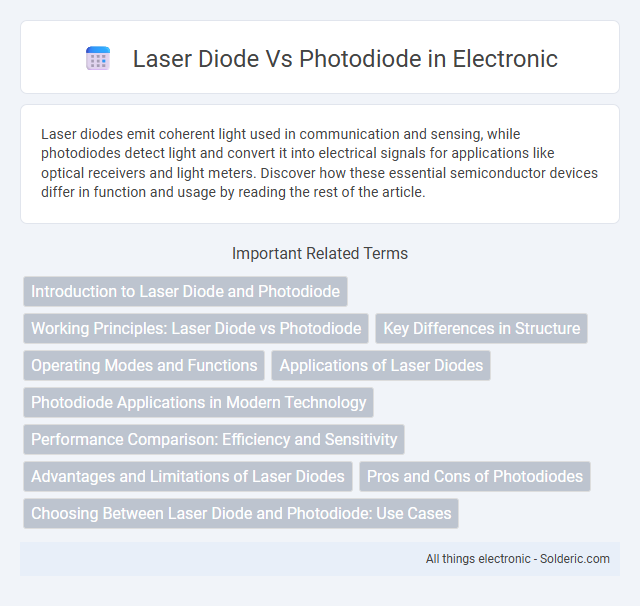Laser diodes emit coherent light used in communication and sensing, while photodiodes detect light and convert it into electrical signals for applications like optical receivers and light meters. Discover how these essential semiconductor devices differ in function and usage by reading the rest of the article.
Comparison Table
| Feature | Laser Diode | Photodiode |
|---|---|---|
| Function | Light source, emits coherent laser light | Light sensor, detects light and converts to electrical signal |
| Operation | Electrically stimulated emission of photons | Photovoltaic or photoconductive effect |
| Applications | Optical communication, barcode scanners, laser pointers | Light measurement, optical receivers, medical devices |
| Wavelength Range | Typically 650 nm - 1550 nm | Broad spectrum, depends on semiconductor material |
| Output | Coherent, monochromatic light beam | Electrical current proportional to incident light |
| Speed | High speed for modulation | Fast response up to GHz range |
| Reverse Bias | Not applicable | Typically operated under reverse bias for sensitivity |
| Size | Compact, semiconductor device | Compact, semiconductor device |
| Cost | Moderate to high depending on power and wavelength | Low to moderate |
Introduction to Laser Diode and Photodiode
Laser diodes are semiconductor devices that emit coherent light through stimulated emission, commonly used in optical communication, barcode readers, and laser printers. Photodiodes are semiconductor sensors that convert light into electrical current, frequently deployed in solar cells, optical detectors, and medical instruments. Both devices rely on the interaction between light and semiconductor materials but serve distinct functions in optoelectronic systems.
Working Principles: Laser Diode vs Photodiode
Laser diodes operate by electrically stimulating a semiconductor material to emit coherent light through stimulated emission, producing a focused laser beam commonly used in optical communication and sensing. Photodiodes function by converting incident light into electrical current via the photoelectric effect, enabling efficient detection of light intensity across various wavelengths. Both devices rely on semiconductor physics but serve contrasting roles: laser diodes as light sources and photodiodes as light detectors.
Key Differences in Structure
Laser diodes consist of a p-n junction designed to produce coherent light through stimulated emission, featuring an active gain medium and reflective cavity to amplify light. Photodiodes are semiconductor devices optimized for detecting light, with a p-n junction engineered to convert incoming photons into electrical current without light amplification. Your choice depends on whether you require light generation, as with laser diodes, or light detection, as with photodiodes, each possessing distinct structural elements tailored to their functions.
Operating Modes and Functions
Laser diodes operate as active light sources by converting electrical energy into coherent light, primarily used for emitting focused laser beams in applications such as fiber-optic communication and barcode scanning. Photodiodes function as light detectors, converting incoming photons into electrical currents to measure light intensity in devices like solar cells and optical sensors. Your choice between these components depends on whether you need to generate laser light or detect and measure it for your specific application.
Applications of Laser Diodes
Laser diodes are widely used in fiber optic communications, barcode scanners, laser printers, and medical devices due to their ability to produce coherent, high-intensity light with precise wavelengths. Their compact size and efficient energy consumption make them ideal for optical data transmission and laser-based sensing technologies. Unlike photodiodes, which are primarily used for light detection in sensors and optical receivers, laser diodes serve as active light sources in various industrial and consumer electronics applications.
Photodiode Applications in Modern Technology
Photodiodes are essential components in modern technology, enabling precise light detection in applications such as optical communication, medical imaging, and environmental sensing. Their high sensitivity and fast response time make photodiodes ideal for converting light into electrical signals in devices like barcode scanners, smoke detectors, and fiber optic systems. Understanding the role of photodiodes helps optimize your choice for accurate and efficient light detection in various technological solutions.
Performance Comparison: Efficiency and Sensitivity
Laser diodes offer superior efficiency in converting electrical energy into coherent light, making them ideal for high-speed optical communication and precise sensing applications where powerful light emission is required. Photodiodes excel in sensitivity, effectively detecting weak light signals with high responsivity and fast response times, critical for accurate light measurement and data reception. Your choice depends on whether efficient light generation or sensitive light detection is the priority in your optical system design.
Advantages and Limitations of Laser Diodes
Laser diodes offer advantages including high efficiency, compact size, and the ability to produce coherent, monochromatic light ideal for precise applications like optical communication and barcode scanning. Their limitations include temperature sensitivity, potential degradation over time, and relatively complex driving circuitry compared to photodiodes. Despite these challenges, laser diodes remain crucial for high-speed data transmission and precise sensing technologies.
Pros and Cons of Photodiodes
Photodiodes offer high sensitivity and fast response times, making them ideal for optical communication and light sensing applications. Their low noise and wide spectral range enhance accuracy, but they require external amplification due to weaker output signals compared to laser diodes. You should consider their limited power handling and slower speed relative to laser diodes when choosing a photodiode for precise detection tasks.
Choosing Between Laser Diode and Photodiode: Use Cases
Laser diodes are ideal for applications requiring coherent light sources, such as optical communication, barcode scanners, and laser pointers, due to their high intensity and directional emission. Photodiodes excel in detecting light intensity for applications like solar cells, optical sensors, and medical devices, benefiting from their fast response time and sensitivity to a wide range of wavelengths. Selecting between the two depends on whether the use case demands light emission or light detection capabilities.
Laser diode vs photodiode Infographic

 solderic.com
solderic.com